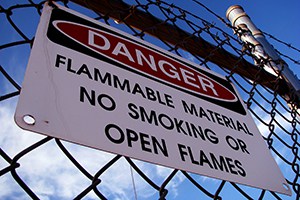The Do’s and Don’ts of Storing Flammables in Your Workplace

Flammable chemicals pose a significant set of potential hazards in the workplace. If they aren’t properly stored and maintained, something as small as a single spark could ignite the chemicals and lead to a massive explosion. Point in case, the 2013 explosion at the West Fertilizer Company plant in Texas which killed over a dozen workers and first responders, leaving many others injured.
Whether you’re working in a laboratory, a manufacturing facility, or a construction site, appropriately storing flammables is crucial to prevent accidents, protect your workforce, and stay compliant with regulations. Here, we’re going to walk you through some do’s and don’ts of flammables storage.
The Do’s:
1. Identify and Label Flammable Chemicals:
- Clearly label all containers with flammable substances to ensure that employees are aware of the potential hazards.
- Maintain an updated inventory of all flammable chemicals, including Safety Data Sheets (SDS) for quick reference.
2. Store Flammable Chemicals in Approved Containers:
- Use containers specifically designed and approved for storing flammable liquids. Metal or approved plastic safety cans with tight-fitting lids are commonly recommended.
- Ensure that containers are grounded to prevent static electricity buildup, especially in areas with a high risk of ignition.
3. Segregate Incompatible Chemicals:
- Store flammable chemicals away from incompatible substances to prevent reactions that could lead to fire or explosions.
- Follow chemical compatibility guidelines and regulations to determine proper storage distances between different types of chemicals.
4. Implement Adequate Ventilation:
- Install proper ventilation systems to reduce the risk of vapor buildup. Good airflow helps dissipate fumes, minimizing the chance of ignition.
- Regularly inspect and maintain ventilation systems to ensure their effectiveness.
5. Comply with Regulatory Guidelines:
- Familiarize yourself with local, state, and federal regulations governing the storage of flammable chemicals. This includes guidelines from agencies such as OSHA, EPA, and NFPA.
- Regularly update your knowledge on regulatory changes and ensure your storage practices remain in compliance.
The Don’ts:
1. Overcrowding and Poor Organization:
- Avoid overcrowding storage areas. Adequate spacing between containers reduces the risk of accidental spills and allows for easier access during emergencies.
- Organize chemicals systematically based on compatibility, hazard class, and frequency of use.
2. Ignoring Fire Safety Equipment:
- Do not overlook the importance of fire safety equipment. Install fire extinguishers, sprinkler systems, and emergency exits as per regulatory requirements.
- Train employees on the proper use of fire safety equipment and conduct regular drills to ensure preparedness.
3. Neglecting Regular Inspections:
- Don’t skip routine inspections of storage areas and containers. Look for signs of leaks, corrosion, or damage that could compromise the integrity of the storage system.
- Promptly address any issues discovered during inspections to prevent accidents.
4. Storing Flammables Near Ignition Sources:
- Keep flammable chemicals away from open flames, electrical equipment, and other potential ignition sources.
- Establish clear no-smoking zones and enforce strict safety measures to prevent accidents.
Know Your Chemical Storage Cabinets
Proper storage begins with companies investing in professional-grade, flame-resistant cabinets to house their flammable chemicals. In the event of a nearby fire or explosion, the chemicals will remain safely locked inside the cabinet rather than fueling the flames. With that said, not all cabinets are made the same. Understanding the distinctions between storage cabinets is vital to choosing the most suitable option for your specific needs.
So, what are the different types of chemical storage cabinets? While there are dozens of different options ranging in size, shape, shelving, features and more, cabinets can generally be categorized into two types: steel and high-density polyethylene.
- Steel storage cabinets offer an exceptional level of strength and durability, while being able to withstand the heat from most fires. The thick, premium-grade steel construction acts as a natural barrier to keep flames away from flammable chemicals. However, some flammable and highly reactive chemicals may necessitate alternative solutions.
- High-density polyethylene (HDPE) cabinets are ideal for storing chemicals that can corrode or burn through steel. HDPE’s corrosion-resistant properties make it suitable for a broader range of chemical storage needs including sulfuric and nitric acids. If you’re looking to store chemicals such as this in your workplace, you’ll want to choose an HDPE cabinet.
Identify Ignition Sources
After securing your flammable chemicals inside the appropriate cabinets, you should perform an inspection of your workplace to identify possible ignition sources. Many businesses and companies perform their day-to-day operations unaware of this information, making them susceptible to fires and explosions.
While each workplace is unique, here’s a short list of some of the most common ignition sources across different industries:
- Still-burning cigarette butts
- Sparks from saws, drills, and other machinery
- Faulty electrical wiring
- Open flames and burners
- Furnace embers
- Steam pipes
- Space heaters
- Hot plates
- Hot bearings
- Welding sparks
- Portable torches
By recognizing possible ignition sources in the workplace, you can make smarter decisions on strategic placement and where to store your flammable chemicals.
Ensuring Comprehensive Safety with AbsorbentsOnline
As you navigate the complexities of storing flammable chemicals, partnering with a trusted source for spill containment solutions and facility safety products is essential. At AbsorbentsOnline, we offer a wide range of top-quality products designed to enhance workplace safety.
Our commitment to providing premium-grade absorbents, spill kits, and containment solutions ensures that you have the tools necessary to address potential chemical spills and accidents. Contact us today!
This is a revision to a blog post with an original publication date of November 6, 2013.